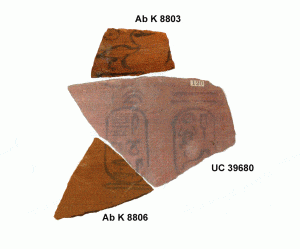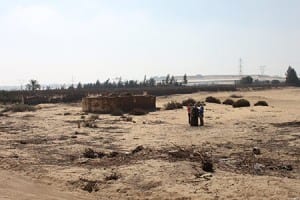From the Field to the Museum and Back Again
By Edmund Connolly, on 1 November 2013
by guest blogger: Alice Stevenson
What are the chances? Two teams of archaeologists separated by a more than century stumbling across small fragments of the same object while working across a wide expanse of desert? Quite high as it happens.
At the turn of the 19th century Flinders Petrie’s teams were trawling through the debris of the tombs of the first rulers of Egypt at a site called Abydos.
One of the thousands of wonderful things discovered during these excavations was a small sherd of pottery marked with the name of the 22nd Dynasty king Oskoron I (c. 922–887 BC). Today this ancient inscription is accompanied by a modern one: a Petrie Museum registration number (UC39680). This little artefact has been tucked in storage here in London for more than one hundred years.

Petrie pottery fragment UC39680 with fragments found by the Deutsches Archäologisches Institut. Courtesy of Andres Effland.
Now in the 21st century, a new generation of archaeologists like Dr Andreas Effland are again out in Abydos investigating the site. And amongst the many new finds that have been made are ceramic fragments that have been shown to join with UC39680. What makes Effland’s discovery so remarkable is the sheer number of pottery sherds that are strewn across the surface of this part of Abydos. How many? I estimate at least a bazillion. It’s this feature that gives the area its modern Arabic name Umm el-Qa’ab, which means ‘mother of pots’. Despite the odds, Effland has been able to note several more links between the splinters happened upon by the Deutsches Archäologisches Institut and those portions recovered by Petrie’s men a century ago now looked after in UCL.
Making these connections across time and space is one of the reasons that I’m always so pleased to welcome current excavators to the Petrie Museum. Recently, one such group of researchers – Dr Joanne Rowland and Dr Geoffrey Tassie – spent a few days in the Petrie recording the Museum’s collection of material from the Neolithic site of Merimde, which is in the western Delta.
Dr Rowland, from the Freie Universität in Berlin, is leading a new project at Merimde and on material from the site in collections worldwide. As a result of their visit, the Petrie Museum material will be on hand as a point of reference as her team re-explores the site and the wider region.

Dr Laura Basell, Rais Omer Farouk and Dr Joanne Rowland at the eastern end of the site of Merimde Beni Salama in spring 2013, rising up to the Pleistocene terraces on the high ground in the west. . Photograph courtesy of Joanne Rowland/Egypt Exploration Society
Current archaeological work in Egypt is constantly changing our ideas about collections. The field site, however, is not just situated along the Nile. The Museum itself is also an assemblage that can contribute to interpretations of archaeological projects in the field. Therefore, while archaeological discoveries are made separately in both locations, they are also frequently made between them.
 Alice is the Curator of the Petrie Museum of Egyptian Archaeology.
Alice is the Curator of the Petrie Museum of Egyptian Archaeology.
One Response to “From the Field to the Museum and Back Again”
- 1
 Close
Close




That’s amazing Alice! Given that there are bazillions of Egyptian pot sherds all around the world, hot did the research team come to put this puzzle together with the Petrie objects? Was it any fancy mapping technology or more traditional techniques one might apply to jigsaw puzzles?